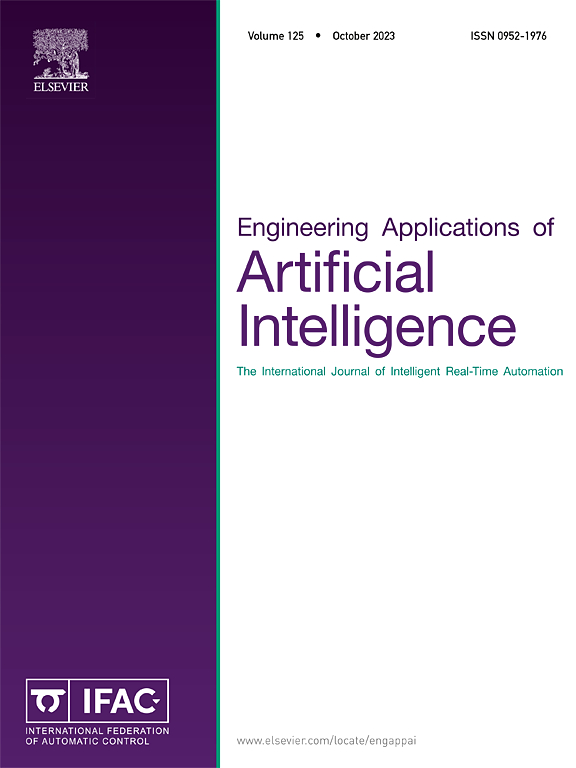基于超宽带变压器神经网络的经济高效的超宽带滑坡实时监测方法
IF 8
2区 计算机科学
Q1 AUTOMATION & CONTROL SYSTEMS
Engineering Applications of Artificial Intelligence
Pub Date : 2025-07-26
DOI:10.1016/j.engappai.2025.111851
引用次数: 0
摘要
滑坡是最具破坏性的自然现象之一,对人类安全、基础设施和生态系统构成重大风险。它们频繁发生在地形复杂的地区,迫切需要开发实时监测解决方案。然而,当前的监测方法受到高昂的成本、有限的时间分辨率和高功耗的限制。这些因素对实施滑坡监测系统造成了巨大的实施障碍。为了解决这些限制,本研究提出了一种经济的实时监测方法,利用超宽带(UWB)技术进行滑坡检测。双微控制器单元(MCU)分布式硬件架构的实现实现了高精度测距能力和高实时性。为了提高超宽带系统在滑坡监测中的空间分辨率,我们提出了一种优化的传感器部署结构和一种新的深度学习架构,称为超宽带变压器(UWBformer)。该网络利用差分超宽带测距数据来预测监测位置的空间位移,特别是位移距离、水平角度和俯仰角。UWBformer采用空间多头注意机制和处理时域和频域特征的双通道架构。它是专门设计的,通过关注相对距离变化而不是绝对距离精度来减轻测距误差传播和提高预测稳定性。实验结果表明,UWBformer在预测位移距离、水平角度和俯仰角方面表现优异,优于传统的Caffery-Taylor (C-T)定位方法,并建立了深度学习基准。现场试验采用3σ准则和卡尔曼滤波对原始测量数据进行预处理,提高了数据的稳定性。综合验证跨现场测试表明UWBformer能够在恶劣环境下保持准确的空间位移估计。本文章由计算机程序翻译,如有差异,请以英文原文为准。
Cost-effective and real-time landslide monitoring method based on ultra-wideband using ultra-wideband transformer neural network
Landslides rank among the most destructive natural phenomena, posing substantial risks to human safety, infrastructure, and ecological systems. Their frequent occurrence in topographically complex regions demands urgent development in real-time monitoring solutions. Current monitoring methodologies, however, are constrained by prohibitive costs, limited temporal resolution, and high-power consumption. These factors create substantial implementation barriers to implementing landslide monitoring systems. To address these limitations, this study proposes an economical real-time monitoring method leveraging ultra-wideband (UWB) technology for landslide detection. The implementation of a dual-Microcontroller Unit (MCU) distributed hardware architecture enables high-accuracy ranging capabilities and high real-time performance. To enhance the spatial resolution of UWB systems in landslide monitoring, we propose an optimized sensor deployment structure and a novel deep learning architecture called Ultra-wideband Transformer (UWBformer). This network utilizes differential UWB-ranging data to predict spatial displacement at monitoring locations, specifically the displacement distance, horizontal angle, and pitch angle. UWBformer incorporates a spatial multi-head attention mechanism and a dual-channel architecture processing both time-domain and frequency-domain features. It is specifically designed to mitigate ranging error propagation and enhance prediction stability by focusing on relative distance changes rather than absolute ranging accuracy. Empirical results demonstrate UWBformer's superior performance in predicting displacement distance, horizontal angle, and pitch angle, outperforming the conventional Caffery-Taylor (C-T) localization approach and established deep learning benchmarks. Field tests incorporated criterion and Kalman filtering alongside to pre-process raw measurements, thereby enhancing data stability. Comprehensive validation across field tests demonstrates UWBformer's capability to maintain accurate spatial displacement estimation under harsh environments.
求助全文
通过发布文献求助,成功后即可免费获取论文全文。
去求助
来源期刊

Engineering Applications of Artificial Intelligence
工程技术-工程:电子与电气
CiteScore
9.60
自引率
10.00%
发文量
505
审稿时长
68 days
期刊介绍:
Artificial Intelligence (AI) is pivotal in driving the fourth industrial revolution, witnessing remarkable advancements across various machine learning methodologies. AI techniques have become indispensable tools for practicing engineers, enabling them to tackle previously insurmountable challenges. Engineering Applications of Artificial Intelligence serves as a global platform for the swift dissemination of research elucidating the practical application of AI methods across all engineering disciplines. Submitted papers are expected to present novel aspects of AI utilized in real-world engineering applications, validated using publicly available datasets to ensure the replicability of research outcomes. Join us in exploring the transformative potential of AI in engineering.
 求助内容:
求助内容: 应助结果提醒方式:
应助结果提醒方式:


